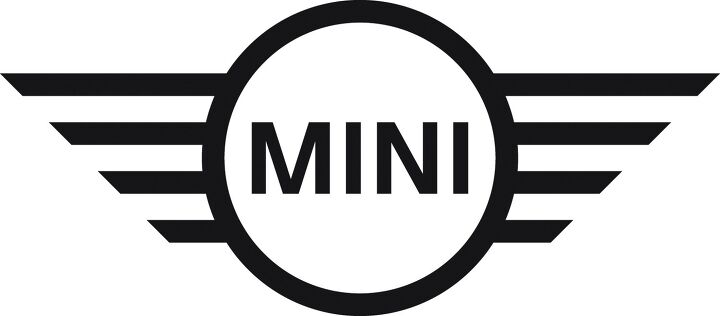Mini Seriously Streamlines Its Badge for 2018

Mini has revealed an ultra-streamlined logo that will begin appearing on the brand’s cars by March of 2018. Abandoning the three-dimensional model as the automaker’s official mark, the new crest isn’t any more exciting but does looks a bit more contemporary.
The new emblem actually made its debut on the Mini EV Concept in late summer. At the time, it wasn’t clear what the purpose of the new logo was. For all we knew it could have been a way of differentiating electrified models from the company’s main lineup, or simply be a way to further streamline the battery-driven concept. Instead, it’s to be the replacement for the old logo and will crop up in all the automotive locales one would expect: the hood, tailgate, steering wheel, and key fob.
However, straying too far from Mini’s current logo probably wouldn’t have made the marketing department happy. Mini thinks the flat, monochrome design makes key graphic elements easier to identify and brand recognition is an essential part of any automaker’s business.
“The preservation of the fundamental, tradition-steeped motif of a winged wheel with the brand name printed in capital letters at the centre ensures the logo will be instantly recognized,” Mini said in a release. “The deliberate avoidance of shading and grey tones creates a starkly contrasting black-and-white effect that conveys the authenticity and clarity of the new brand identity, its two-dimensional character also allowing universal application.”
The strategy is very similar to what BMW is doing with its own logo on flagship models. Of course, this should come as no surprise — BMW Group has owned Mini since 2000.
[Image: BMW Group]

A staunch consumer advocate tracking industry trends and regulation. Before joining TTAC, Matt spent a decade working for marketing and research firms based in NYC. Clients included several of the world’s largest automakers, global tire brands, and aftermarket part suppliers. Dissatisfied with the corporate world and resentful of having to wear suits everyday, he pivoted to writing about cars. Since then, that man has become an ardent supporter of the right-to-repair movement, been interviewed on the auto industry by national radio broadcasts, driven more rental cars than anyone ever should, participated in amateur rallying events, and received the requisite minimum training as sanctioned by the SCCA. Handy with a wrench, Matt grew up surrounded by Detroit auto workers and managed to get a pizza delivery job before he was legally eligible. He later found himself driving box trucks through Manhattan, guaranteeing future sympathy for actual truckers. He continues to conduct research pertaining to the automotive sector as an independent contractor and has since moved back to his native Michigan, closer to where the cars are born. A contrarian, Matt claims to prefer understeer — stating that front and all-wheel drive vehicles cater best to his driving style.
More by Matt Posky
Latest Car Reviews
Read moreLatest Product Reviews
Read moreRecent Comments
- Olivehead The Honda Civic wins on looks and interior material quality and style. The Civic looks like a scaled down "real" car (i.e., midsize) while the Corolla never lets you forget what it is-a compact car, harkening back to the Tercel, etc. No comparision either in the interior materials of the Civic (a notch below Acura level) and general layout. There too, the Corolla comes off as a compact runabout. The Civic hatchback is especially cool.
- Mike Beranek While the product may appear to be "better", only time will tell. The American automotive environment can chew a car up and spit it out. Will these Chinese EVs survive like a quarter-century old Cavalier, or will they turn out like VinFast's "cars"?
- Mike Beranek This police vehicle will be perfect for when the State of Florida starts tracking every pregnancy.
- Dave M. The Highlander hybrid, a larger, heavier vehicle, gets better mpgs. Why? Also, missed opportunity - if Toyota had made this a hatchback, they could have scooped up the "want a Tesla S but not ready for a full EV" crowd, however small or large they may be....
- TheMrFreeze Difficult call...the more the mainstream automakers discontinue their more affordable models and only sell crazy overpriced EVs and trucks, the more appealing the idea of letting in cheap imported cars becomes with the buying public. If the government is going to impose tariffs on Chinese vehicles, at the same time they need to be getting with the Big 3 and telling them to fill the void with affordable models and not use the tariff as an excuse to simply raise prices. Otherwise, public pressure could see the tariffs withdrawn.I seem to recall the last administration put a 25% tariff on Chinese steel, at which point the US manufacturers immediately used the opportunity to raise their prices 25%...that needs to not happen.

































Comments
Join the conversation
I like it! The badge not the car. Ironically it reminds me of the USAF insignia not the British.
Any time you see a company "flatten" or otherwise simplify their logo, the intent is to increase legibility on a smartphone. It's funny, long ago company logos were largely constrained by print-related factors -- cost of using multiple colors or amount of embellishment based on the dpi available at the printer. All that went away in the 2000s and we had an explosion of color gradients and 3D shading as color printing became cheap and video resolution (and screen size) increased. Now the measure is how clean does it render when it's 1cm x 1cm on a 4" wide screen you glance at during red lights. I understand the intent, but from a lot of logos you'd think it was the 1920s again. Which is why I was actually surprised that Buick elected to reintroduce color to the tri-shield.